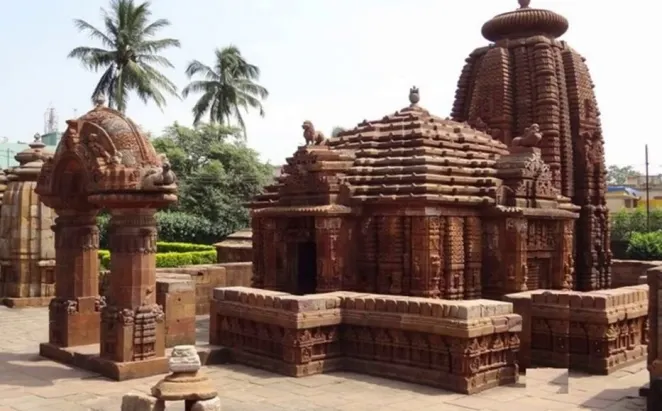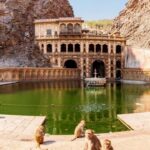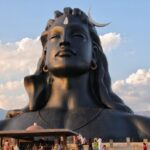15 Unusual & Interesting Temples Which Could Have Existed Only In India-
Jaipur’s Chandreshwar Mahadev Temple
Jaipur’s Chandreshwar Mahadev Temple A massive Ramchandra Temple can be seen in Jaipur near the entrance of Sirah. To the south of this historic temple’s courtyard is a gigantic gate via which one can access the stunning Chandreshwar Mahadev Temple. This shrine is a beautiful example of a Jaipur sculpture that may draw in any art enthusiast. This two-story temple is worth seeing for the expressive and detailed carvings on the marble pillars. The Lord Shiva-focused Chandrashwar temple bears the name of Queen Chandrawati. There is a slight romantic undertone to the temple’s construction because it is stated that the Maharaja built it for his Queen.
Jaipur’s Pataleshwar Mahadev Temple
Temple of Patalwahwar Mahadev Jaipur One of Jaipur’s undiscovered treasures is the Pataleshwar Mahadev Temple, which is thought to be 400 years old. This Shiva Temple, which is located in the Rajput Colony of Jhalana Dungri, is reported to have been discovered in 1977. The temple was buried 20 feet under the dirt, according to the villagers. After persistent local efforts, the temple could be unearthed, and today it is surrounded by a well-like structure with 20-foot-tall walls. To get to the temple, you must down roughly 19 stairs. In the area, there is also a Hanuman temple that attracts a sizable following during Shivratri.
Temple of Tanot Mata in Jaisalmer
Temple of Tanot Mata in Jaisalmer Tanot Mata Temple is one of the holy sites in Rajasthan that you should be aware of because of its intriguing location on the Indo-Pak border. This shrine, which is dedicated to the goddess Durga, has a fascinating backstory. According to folklore, this bordering temple was the target of the Pakistani army during the 1965 conflict between India and Pakistan. All of the Pakistani army’s attempts to bombard this location are thought to have failed. Both the temple and the soldiers stationed here escaped without damage. Grenades and other weapons used against the Indian troops are preserved in the shrine as evidence.
Jaipur’s Rameshwar Temple
Jaipur’s Rameshwar Temple Rameshwar is a 250-year-old temple in Jaipur that is situated next to Vidyadhar Gardens and a former ghat. Maharaja Ram Singh, who is thought to be a follower of Lord Shiva, is supposed to have given the order for the temple to be constructed. This shrine, which was built contemporaneously with the Rameshwar Temple in the Amer Fort, resembles the earlier structure in terms of sculpture. The surroundings of this temple also house an idol of Kartikeya and the presiding deity, Goddess Parvati, just like the sanctum of the Rameshwar shrine in the Amer Fort. The pristine Aravallis backdrop adds to the revered and mystical atmosphere of this sacred sanctuary.
Ranchi’s Pahari Baba Mandir
Ranchi’s Pahari Baba Mandir One of Ranchi, Jharkhand’s crown jewels is Pahari Baba Mandir, which is located atop Ranchi Hill. Pahari Baba Temple, which is devoted to Lord Shiva, bears witness to the sacrifice made by Indian freedom fighters. The shrine is supposedly located where numerous freedom fighters were executed as a penalty for rebelling during British control. The Indian flag is still flown here on Independence Day and Republic Day in remembrance of those who gave their lives fighting for the country’s freedom. A proclamation of independence is written on a rock not far from this revered shrine. Definitely a location to treasure and respect.
Jaipur’s Ambikeshwar Mahadev Temple
This Jaipur temple, which is located in the Amer Fort, is of tremendous religious significance. The Shivling in this location is thought to be a natural one that was built 22 feet beneath the surface of the ground. According to mythology, King Kankil Dev owned a cow that only provided milk when she was in a specified location. The King, who was taken aback, made the decision to have the site investigated. A Shivling was discovered during the excavation, thus the King gave the order to build a temple there. Even though the Shivling is still there, a devotee must peer inside to see it because it is now protected by a circular hole. It is said that the Shivlinga is submerged in 10 feet of water during the monsoon season.
Jaipur’s Kala Mahadev Temple
The Kala Mahadev Temple, which is surrounded by Aravalli Hills, is unique among Jaipur’s Shiva Temples. This sacred site, which is accessible from all four corners, is renowned for providing unmatched calm and views of Jaipur. This sacred site in Jaipur is further enhanced by the surrounding Kanak Valley and Kanak Vrindavan. It is thought that Maharaja Man Singh gave the order to build this temple in accordance with all Tantric procedures. The Shivlinga, together with statues of Nandi, Parvati, Ganesha, and Kartikeya, serves as the location’s presiding idol.
Pragpur’s Mahakaleshwar Temple
A widespread misconception regarding this temple, which is located in Pragpur in the Kangra Valley of Himachal Pradesh, is that the Shivlinga is gradually settling beneath the earth. When the planet is filled with evil powers, it is thought that the Shivlinga will completely disappear. This temple is associated with a lot of legends. Believers also acknowledge the temple as the entrance to Hades, where the saints travel to worship Lord Shiva. Even Ravana, according to tradition, used to stop here on his route to Mount Kailash, where he worshipped Lord Shiva. Additionally, it is said that the temple is where the Pandavas sought the blessing of success in their conflict with the Kauravas.
Mangalagiri’s Sri Panakala Lakshmi Narasimhaswamy
Sri Panakala Lakshmi Narasimhaswamy, perched atop the hill, is thought to be perched on a volcano, which, should it ever erupt, will bring down the entire temple and the area around it. The worshippers think that since Lord Vishnu is in charge of it, the volcano won’t ever erupt. In the belief that Lord Vishnu won’t permit the volcano to erupt, a special Prasadam made of jaggery water is served here and is referred to as Panakam. The temple is well-known in the neighbourhood and is surrounded by a few other temples.
Jaipur’s Rameshwar Mahadev Temple
One of the most well-known locations in Jaipur is perhaps the Rameshwar Mahadev Temple, which is located in the magnificent fort of Amer. The Rameshwar Mahadev temple, which is devoted to Lord Shiva, is a remarkable example of Rajput construction and demonstrates an unwavering belief in the strength of Lord Shiva. The shrine bears Maharaja Ram Singh’s name because he built it. The deity of Lord Shiva and his bride Parvati, as well as their offspring Lord Ganesha and Kartikeya, have all been kept apart from one another, which gives the temple its allure as a site of worship despite the fact that it is surrounded by the fort’s lush green gardens.
Jaipur’s Pataleshwar Temple
Jaipur’s Pataleshwar Temple Due to its gorgeous architecture and lengthy history, this temple is well known among its followers. Approximately 150 years ago, during an excavation, idols of Lord Shiva and his complete family were discovered 10–12 feet under the surface. It is thought that Sawai Madho Singh gifted a piece of land to a saint at that time. After the excavation, the worshippers built a temple in this location. The fact that the drainage system around the Shivlinga is connected to a well located on the temple grounds furthers the allure of the structure by ensuring that the water applied to the Shivlinga is not lost. The temple’s red exterior walls are beautifully carved, and the interior is also beautifully carved.
Bhakura Mahadev/Buteshwar Nath Temple, Marauda Village, Chhattisgarh
Temple of Bhuteshwar Nath This temple in the Chhattisgarh town of Marauda is renowned for its Shivlinga and is a must-see. This Shivlinga is reputed to grow taller every year as it stands in the middle of a forest. Locals claim that the Shivlinga grows by at least 6 to 8 inches each year. It is believed that the land on which the Shivlinga is located belonged to a Zamindar by the name of Shobha Singh, who once heard the bellow of the bull and the roar of the lion while wandering nearby. Shobha Singh took a few people with him to the location where he heard the sounds, and they discovered an oddly absent lion and bull
Hathroi and Dhuleshwar Mahadev
Hathroi and Dhuleshwar Mahadev This temple, which is situated in Rajasthan close to Hathroi and has a mythology attached to it, is a unique place of worship. It is stated that the temple has the ability to grant people’s wishes and provide complete peace of mind. According to mythology, this location was once frequented by a Rawal of Samona Thikana who had a contract to build a temple there. The Rawal once used a naturally occurring Shivlinga as a peg and hitched his elephant to it. In his dream, Lord Shiva approached and urged him not to.
Temple at Gupta Dham Cave, Rohtas, Bihar
Temple in Gupta Dham Cave The Kaimur plateau contains the cave temple known as Gupta Dham. A limestone Shivalinga can be found inside the cave. Inscriptions on the interior walls that have not yet been interpreted, according to historians, may contain important information. After entering the cave far enough, there is a ravine there named Paatal Ganga. A path leading to another cave can be found in the midst of this one. A fair is held here during Basant Panchami and Navratras, and visitors from all across the nation come to witness it.
Jaipur’s Geteshwar Mahadev
Jaipur’s Geteshwar Mahadev A well-known Shiva Temple in Rajasthan is called Geteshwar Mahadev, and it is situated on Gad Ganesh Hill. The nearly 500 steps that lead up to this ancient temple draw pilgrims from all around the nation. According to legend, the temple was named for the reigning King, whose name was Gate. The Goddess Parvati, Jagadamba, and Nandi idols are all present in the little, dome-shaped temple. A sizable number of followers of Lord Shiva come here to worship him every Monday and during Shivratri.








